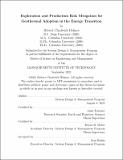| dc.contributor.advisor | Fournier, Aimé | |
| dc.contributor.advisor | Moser, Bryan R. | |
| dc.contributor.author | Holmes, Robert Chadwick | |
| dc.date.accessioned | 2022-02-07T15:12:28Z | |
| dc.date.available | 2022-02-07T15:12:28Z | |
| dc.date.issued | 2021-09 | |
| dc.date.submitted | 2021-10-21T19:55:06.418Z | |
| dc.identifier.uri | https://hdl.handle.net/1721.1/139915 | |
| dc.description.abstract | Geothermal provides a continuous, low-emissions source of energy with enormous potential in the United States, both singularly or as part of a broader energy mix. Although a small contributor to the current national energy grid, geothermal electricity generation dates back nearly a century for natural hydrothermal systems. More recently, enhanced geothermal systems (EGS) promise a broader reach with engineered solutions for extracting subsurface heat from a wider variety of locations. The potential synergy between the oil & gas and geothermal offers an opportunity for building a lower-carbon energy portfolio that requires compatible skills and expertise. Nevertheless, the risks involved at multiple stages of the field lifecycle remain a hurdle to adoption of geothermal.
In this thesis, risk-mitigation strategies for geothermal target two phases of the lifecycle: exploration and production. The first strategy uses a diverse set of measurements spanning multiple interrelated earth systems to collectively determine geothermal potential at the play scale. Analytical workflows integrate geologic, geochemical, and geophysical data to estimate subsurface geothermal gradient, with quantitative uncertainty estimates associated with the measurements, the models, and the solution space. These uncertainty estimates provide a measure of risk, as well as decision tools for investments in additional data-gathering activities before the first well is drilled. The second strategy applies flexibility in engineering design to a hypothetical EGS expansion of an existing power facility. Specifically, key uncertainties are integrated into a cost model with operational decision rules to create an ensemble of possible outcomes. Tailoring the model and decision rules to a particular facility concept allows for a rapid feasibility testing and optimization of project actions that limit downside risk while capturing upside potential. Both of these strategies use uncertainty characterization to reduce the threat of high-consequence geothermal risks. And by including them in a broader risk management approach, oil & gas companies can make data-driven decisions on investing in geothermal during the energy transition. | |
| dc.publisher | Massachusetts Institute of Technology | |
| dc.rights | In Copyright - Educational Use Permitted | |
| dc.rights | Copyright retained by author(s) | |
| dc.rights.uri | https://rightsstatements.org/page/InC-EDU/1.0/ | |
| dc.title | Exploration and Production Risk Mitigation for Geothermal Adoption in the Energy Transition | |
| dc.type | Thesis | |
| dc.description.degree | S.M. | |
| dc.contributor.department | System Design and Management Program. | |
| dc.identifier.orcid | https://orcid.org/0000-0002-7884-9843 | |
| mit.thesis.degree | Master | |
| thesis.degree.name | Master of Science in Engineering and Management | |
